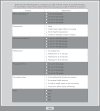Adaptive choice-based conjoint analysis: a new patient-centered approach to the assessment of health service preferences
- PMID: 22273433
- PMCID: PMC3580138
- DOI: 10.2165/11537870-000000000-00000
Adaptive choice-based conjoint analysis: a new patient-centered approach to the assessment of health service preferences
Abstract
Conjoint analysis (CA) has emerged as an important approach to the assessment of health service preferences. This article examines Adaptive Choice-Based Conjoint Analysis (ACBC) and reviews available evidence comparing ACBC with conventional approaches to CA. ACBC surveys more closely approximate the decision-making processes that influence real-world choices. Informants begin ACBC surveys by completing a build-your-own (BYO) task identifying the level of each attribute that they prefer. The ACBC software composes a series of attribute combinations clustering around each participant's BYO choices. During the Screener section, informants decide whether each of these concepts is a possibility or not. Probe questions determine whether attribute levels consistently included in or excluded from each informant's Screener section choices reflect 'Unacceptable' or 'Must Have' simplifying heuristics. Finally, concepts identified as possibilities during the Screener section are carried forward to a Choice Tournament. The winning concept in each Choice Tournament set advances to the next choice set until a winner is determined.A review of randomized trials and cross-over studies suggests that, although ACBC surveys require more time than conventional approaches to CA, informants find ACBC surveys more engaging. In most studies, ACBC surveys yield lower standard errors, improved prediction of hold-out task choices, and better estimates of real-world product decisions than conventional choice-based CA surveys.
Figures




Similar articles
-
The Role of Web-Based Adaptive Choice-Based Conjoint Analysis Technology in Eliciting Patients' Preferences for Osteoarthritis Treatment.Int J Environ Res Public Health. 2023 Feb 14;20(4):3364. doi: 10.3390/ijerph20043364. Int J Environ Res Public Health. 2023. PMID: 36834057 Free PMC article.
-
Generating Individual Patient Preferences for the Treatment of Osteoarthritis Using Adaptive Choice-Based Conjoint (ACBC) Analysis.Rheumatol Ther. 2017 Jun;4(1):167-182. doi: 10.1007/s40744-017-0056-4. Epub 2017 Mar 2. Rheumatol Ther. 2017. PMID: 28255898 Free PMC article.
-
Consumer Perception of Retail Pork Bacon Attributes Using Adaptive Choice-based Conjoint Analysis and Maximum Differential Scaling.J Food Sci. 2017 Nov;82(11):2659-2668. doi: 10.1111/1750-3841.13934. Epub 2017 Oct 23. J Food Sci. 2017. PMID: 29058811
-
Eliciting public preferences for healthcare: a systematic review of techniques.Health Technol Assess. 2001;5(5):1-186. doi: 10.3310/hta5050. Health Technol Assess. 2001. PMID: 11262422
-
A Systematic Review of Discrete-Choice Experiments and Conjoint Analysis Studies in People with Multiple Sclerosis.Patient. 2018 Aug;11(4):391-402. doi: 10.1007/s40271-017-0296-y. Patient. 2018. PMID: 29313265
Cited by
-
Measuring customer satisfaction on the cleanliness of food premises using fuzzy conjoint analysis: A pilot test.PLoS One. 2021 Sep 1;16(9):e0256896. doi: 10.1371/journal.pone.0256896. eCollection 2021. PLoS One. 2021. PMID: 34469489 Free PMC article.
-
Determining patient preferences for the medical management of osteoporosis using conjoint analysis.Osteoporos Int. 2024 Jan;35(1):153-164. doi: 10.1007/s00198-023-06882-9. Epub 2023 Sep 18. Osteoporos Int. 2024. PMID: 37721558 Free PMC article.
-
Examining Parents' Preferences for Group and Individual Parent Training for Children with ADHD Symptoms.J Clin Child Adolesc Psychol. 2016 Sep-Oct;45(5):614-631. doi: 10.1080/15374416.2015.1004678. Epub 2015 Feb 20. J Clin Child Adolesc Psychol. 2016. PMID: 25700219 Free PMC article.
-
The Patient Perspectives on Future Therapeutic Options in NASH and Patient Needs.Front Med (Lausanne). 2019 Apr 3;6:61. doi: 10.3389/fmed.2019.00061. eCollection 2019. Front Med (Lausanne). 2019. PMID: 31106203 Free PMC article.
-
Patient Preferences: Results of a German Adaptive Choice-Based Conjoint Analysis (Market Research Study Sponsored by Eli Lilly and Company) in Patients on Palliative Treatment for Advanced Breast Cancer.Breast Care (Basel). 2021 Oct;16(5):491-499. doi: 10.1159/000513139. Epub 2021 Jan 25. Breast Care (Basel). 2021. PMID: 34720809 Free PMC article.
References
-
- Lomas J. Reluctant rationers: public input to health care priorities. J Health Serv Res Policy. 1997;2(2):103–11. - PubMed
LinkOut - more resources
Full Text Sources
